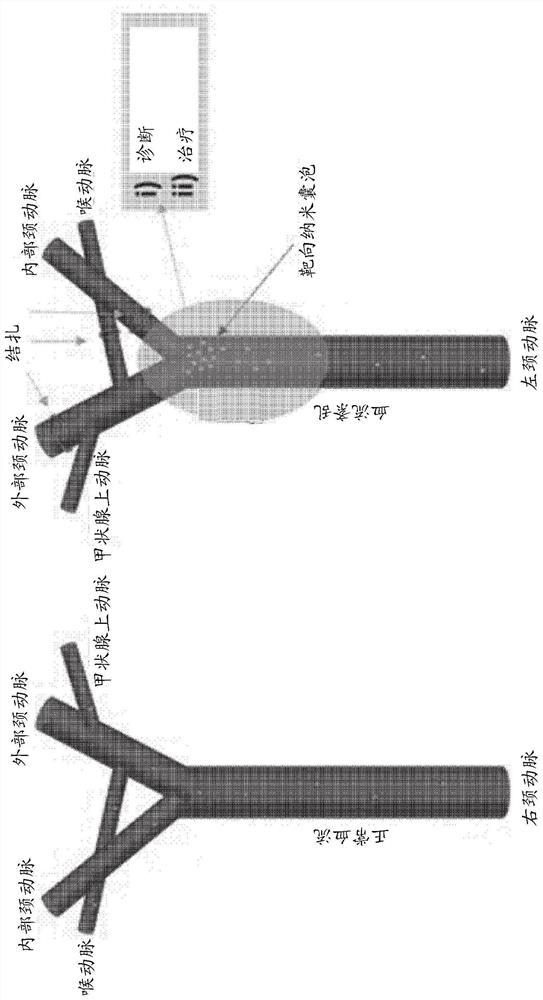Method for diagnosing and treating arteriosclerosis using blood flow change site-targeted nanovesicles
A technology of nanovesicles and arteriosclerosis, which is applied in the direction of peptides containing positioning/targeting motifs, nanomedicine, nanotechnology, etc., and can solve problems such as difficulties
- Summary
- Abstract
- Description
- Claims
- Application Information
AI Technical Summary
Problems solved by technology
Method used
Image
Examples
preparation example Construction
[0069]Moreover, the present invention provides a method for preparing the above-mentioned nanovesicles, which comprises obtaining from stem cells transfected with a vector transfected with a coding sequence of a signal peptide-blood flow disturbance site-targeting peptide-transmembrane protein-green fluorescent protein Steps for displaying on the surface of nanovesicles targeting peptides at sites of blood flow disturbances.
[0070] In the present specification, "blood flow disorder" refers to abnormal and irregular blood flow due to the structural characteristics of blood vessels, and is an event of early arteriosclerosis leading to dysfunction of vascular endothelial cells.
[0071] In this specification, "nanovesicles (NV)" refers to artificially pulverizing cells by passing them through a filter to prepare by self-assembly, which should be understood as different from exosomes extracted from cells .
[0072] The present invention provides stem cell-derived nanovesicles f...
Embodiment 1
[0101] Example 1: Preparation and Characterization of PREY Peptide-Nanovesicles
[0102] Design and cloning of plasmids for PREY expression
[0103] The plasmid that expresses and localizes PREY on the outside of the cell membrane consists of the N-terminal on the outer side-promoter-signal peptide-PREY-V5-transmembrane protein-green fluorescent protein-C-terminus on the inner side. As the signal peptide, signal peptide F (BKU002587, Korean Human Gene Bank, Korea) or signal peptide R (BKU008396, Korean Human Gene Bank, Korea) was used. In the plasmid sequence, i) a signal peptide induces the localization of the PREY peptide to the outside of the cell membrane; and ii) the V5 tag and green fluorescent protein monitor the position and expression level of PREY. Expression vectors were cloned by using the NEB Gibson Assembly kit (New England Biolabs, MA) according to the manufacturer's instructions. Each type of signal peptide and transmembrane protein was separately amplified b...
experiment example 1
[0137] Experimental Example 1: Displaying RPEY on the outside of the membrane
[0138] In order to target nanovesicles to sites of blood flow disturbance, PREY as a targeting peptide is externally displayed by expressing a specially designed plasmid across the membrane of mesenchymal stem cells (PMSC: PREY-expressing human mesenchymal stem cells) . The plasmid was designed to express the signal peptide and the PREY ectodomain at the N-terminal, whereby the signal peptide induces localization from the mesenchymal stem cell membrane to the outer side of the PREY ectodomain and inactivates the induction signal by cleavage.
[0139] Also, the ability of 3 transmembrane proteins for improving the expression of PREY, ie, exosomal marker (CD86) and mesenchymal stem cell markers (CD105 and CD271), was tested. In this way, the ability of PREY to search and target sites of blood flow disturbance is maximized. After PREY is connected to the V5 tag, it is connected to the green fluoresc...
PUM
 Login to View More
Login to View More Abstract
Description
Claims
Application Information
 Login to View More
Login to View More - R&D
- Intellectual Property
- Life Sciences
- Materials
- Tech Scout
- Unparalleled Data Quality
- Higher Quality Content
- 60% Fewer Hallucinations
Browse by: Latest US Patents, China's latest patents, Technical Efficacy Thesaurus, Application Domain, Technology Topic, Popular Technical Reports.
© 2025 PatSnap. All rights reserved.Legal|Privacy policy|Modern Slavery Act Transparency Statement|Sitemap|About US| Contact US: help@patsnap.com



